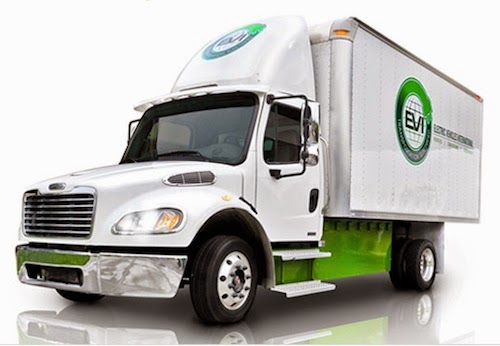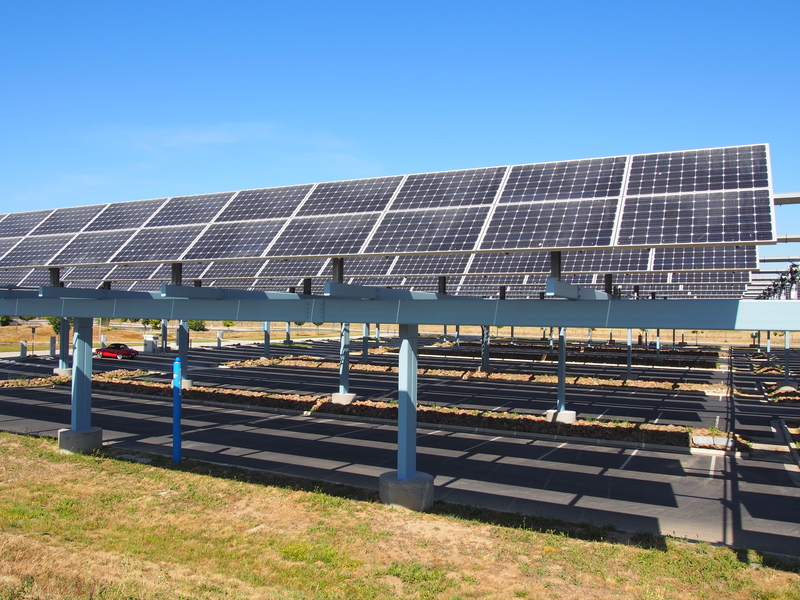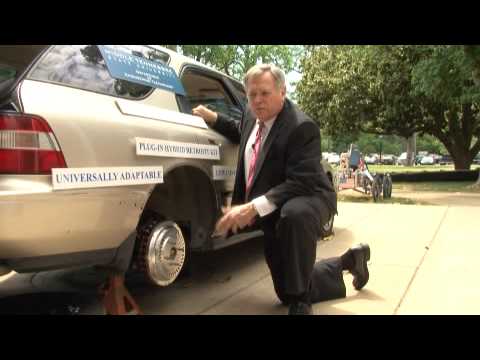I think there may be overly high expectations of what solar panels can do. I came across a project idea to develop a product that can be added to any car, using solar panels to somehow reduce gasoline consumption. The project write-up did not propose a given solution, but instead asked for a solution. Unfortunately the idea itself is unworkable and unfeasible, simply because of the physics.
The first step to implementing the idea would be an add-on electric drive system like this:
This is a retrofit kit converting any car into a plug-in hybrid. It uses an electric motor built into a car wheel. The electric motor control system is designed to add power to the car at low speeds, and not induce any drag when the motor is not in use. As shown in this video, trunk space is taken up by motor controllers and a battery pack. Any competent electric motor controller designer could put together a more compact control system, and that simply leaves the issue of a location for the energy storage (a battery pack).
There are several possible sources of such in-wheel electric motors. The point here is that this is the easiest method to retrofit an electric drive assist into any car. Once you have such a motor mounted on the car, it’s easy to reduce gasoline consumption by using electricity to power the motor.
This is where we start considering how to use solar panels in such a retrofit.

Solar power on an electric car – degrades aerodynamics
There are three basic problems. The most glaring is aerodynamics. Take an existing car, add solar panels, and it’s very hard to avoid the problem shown here.
Existing cars are designed with their aerodynamic shape while solar panels are flat and rectangular. The two shapes are incompatible. The car shown here will have had lots of inefficiency because the solar panels degrade the aerodynamics. It therefore would require more energy to travel through the atmosphere.
The second problem is orientation. To get anywhere near optimum electricity production, the solar panels must be oriented correctly to the Sun meaning the panels should directly face the Sun and be tilted at the correct angle. You can see from the shadows in this picture, this car was pointed about 90 degrees away from the Sun. Parking lots are not designed so cars can efficiently capture solar energy, instead parking spaces are oriented however they’re oriented, and the car driver with solar on their car can only park as allowed. If the solar panels are to be used while driving, there’s no way in heck to ensure any kind of optimum orientation. And what about parking lots or driving situations where sunlight is blocked, like an underground parking lot, or a tree-lined road, or a road surrounded by skyscrapers? Cars end up in lots of situations where collecting solar energy will be impractical.
The third problem is power availability. There isn’t enough space on a typical car to hold enough panels to provide enough power to do anything sufficient. This car here, it has four panels, and might produce 1000 watts in optimum conditions. Clearly it will be difficult to have optimum conditions, limiting the solar production possible. Even if you can get 1000 watts out of panels retrofitted to a car, it can easily require 100 kiloWatts to move the car. In other words, you’ll only get a tiny fraction of the energy required using on-board solar panels.
In summary we have these observations
- Retrofitting solar panels onto a car will almost certainly degrade the aerodynamics to where it’s a big loss
- Retrofitted solar panels will be unable to provide much power
- It’ll be difficult to get good solar production from a parked car — In a moving car, it will be nigh-on impossible

Stella – Eindhoven Univ’s solar powered family car – http://www.solarteameindhoven.nl/
These cars are a counter-example. They’re purported to be four-passenger cars with cargo space allowing them to be used in regular driving situations around town. I’ve seen one of those cars in person, and I have my doubts over whether the passenger cabin would be acceptable to the general public.
They are an example of a purpose-designed car with a good integration of solar panels, energy storage and an electric drive train. In other words, while retrofitting solar power onto a regular car is completely impractical, it is in theory possible to purpose-design a car so solar power will work well. The driver of such a car will still have the issue of parking to capture optimum solar power, but other issues are solved like aerodynamics and solar production.

Consider a different kind of vehicle, however. This is an actual electric truck meant for around-town deliveries. These kind of trucks have a great spot on which to install solar panels without degrading aerodynamics — the top of the cargo box. Just put a solar array on top, a charge controller connected to the battery pack, and you’re good-to-go with a solar assist. I would also want to redesign some bits of this vehicle to improve aerodynamics.
For more details see: The number of solar panels required to power an electric car![]() and Why an electric car can’t power itself
and Why an electric car can’t power itself![]()

My absolute last point is that THIS is the most effective way to use solar power to support transportation. Solar facilities are large enough to be best used in a fixed installation like this. And, if you look carefully, tucked away at the left-hand-side is a little red car underneath the solar panels. That is the Karmann Ghia electric car I built a few years ago, charging at a charging station. For the curious, this is a community college in Newark CA. That day I had a warm fuzzy feeling that the electricity used to drive my car came from solar power.
See Solar panel covered parking lots with charging stations underneath – EV Nirvana![]()
- Is there enough Grid Capacity for Hydrogen Fuel Cell or Battery Electric cars? - April 23, 2023
- Is Tesla finagling to grab federal NEVI dollars for Supercharger network? - November 15, 2022
- Tesla announces the North American Charging Standard charging connector - November 11, 2022
- Lightning Motorcycles adopts Silicon battery, 5 minute charge time gives 135 miles range - November 9, 2022
- Tesla Autopilot under US Dept of Transportation scrutiny - June 13, 2022
- Spectacular CNG bus fire misrepresented as EV bus fire - April 21, 2022
- Moldova, Ukraine, Georgia, Russia, and the European Energy Crisis - December 21, 2021
- Li-Bridge leading the USA across lithium battery chasm - October 29, 2021
- USA increasing domestic lithium battery research and manufacturing - October 28, 2021
- Electrify America building USA/Canada-wide EV charging network - October 27, 2021
















